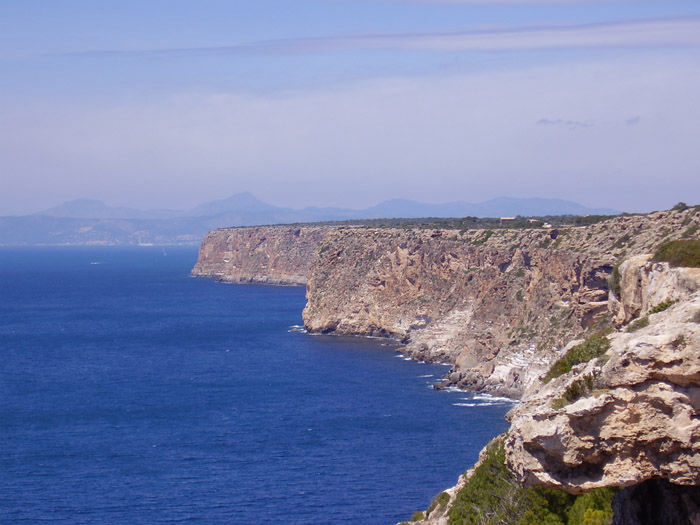
INTRODUCTION

Welcome to this audioguide. The name of Llucmajor is probably composed by the Latin words lucus maioris, which mean “greater forest”. Semantically, it is likely that the called farmstead Llucmajor was populated with a great forest. The prehistoric settlement of Capocorb Vell, in the south of Llucmajor, is the most known exponent of the Bronze Age.
It represents a myth within the prehistoric investigation thanks to its conservation and it is the most important talayotic settlement in the East Mediterranean. Also, it is one of the most extensive settlements of the island as well as one of the first places that have been excavated and studied.
Phoenicians, Greeks, Carthaginians and Romans left their influence until the arrival of the Christianity. A fragmented tablet is the only testimony of those times and written in it only a single word as a toponym “Egnatuleia”.
After several attempts, in 902, Mallorca was submitted under Arab dominion and followed by a stage of growth and prosperity.It is considered, that Llucmajor existed as an Arab farmhouse, depending on the municipality of Montuïri.
Later, in 1229, the island of Mallorca was conquered by the king Jaume I. We have to emphasize, that the most important milestone of our history has been the Battle of Llucmajor “Sa Batalla de Llucmajor”, that took place on the 25th October 1349.
In this combat, Jaume III, the last king of Mallorca, was defeated and he lost his kingdom, thus being annexed to the Kingdom of Aragón. In 1543 the emperor Carlos V granted to Llucmajor the real privilege to celebrate fairs from the 29th September to the 18th October, as well as a weekly market, which takes place still nowadays on Wednesday and on Friday.During the centuries XIVth to XVIIIth the South coast of Mallorca suffered the continuous threat of pirates and corsairs expeditions which attacked the Mallorcan coasts without breath.
The towers of S’Estelella, Cap Blanc, Cap Enderrocat and Cala Pi are witnesses of those fights. The convent of San Bonaventura was built in the XVIIth century and was the penultimate one founded by the Franciscans on the island. The parish church of Sant Miquel, which construction began in 1781, was erected by the architect Isidro González Velázquez.
Llucmajor was always a very important place thanks to the agriculture and livestock and also one of the more outstanding industrial poles of Mallorca in the shoe industry, today replaced by the tourism, sausages and liquors industry, in addition to outstanding crafts of stone, iron and wood. You will be able to discover all this and more with this audioguide. By a Real Decree of 3rd October 1916, the king Alfonso XIII granted Llucmajor the title of “ciutat”, city.In October 1916, was constructed the new municipal market, and was also inaugurated the Palma-Santanyí railroad with station in Llucmajor and on 25th November of that year was founded the first electrical power station “El Porvenir”, that opened the possibility to the electrical public lighting system.
The first decades of the XXth century in Llucmajor, are marked by a series of chained events that marked to a stage of progress and development. There is a fort demographic increase that corresponds with a stage of economic expansion. Many great properties have been divided into plots and sold piece to piece, where a lot of almond trees have been seeded.
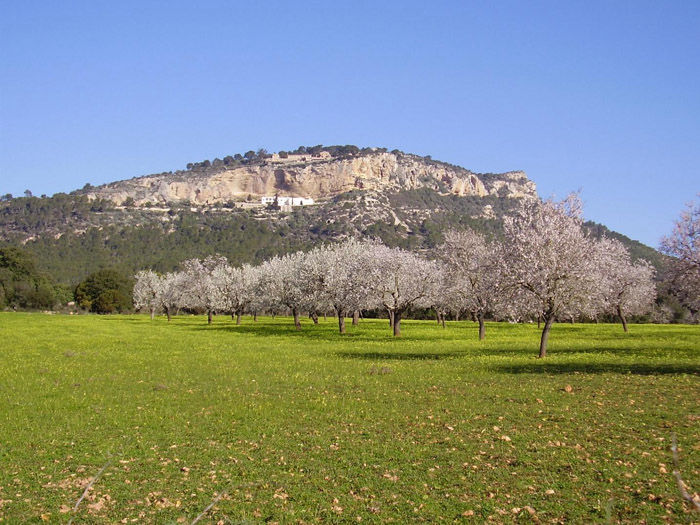
The strong industrialization, specially in the branch of the footwear, that nowadays has disappeared practically, being today the services industry the most outstanding.
PLACE OF INTEREST
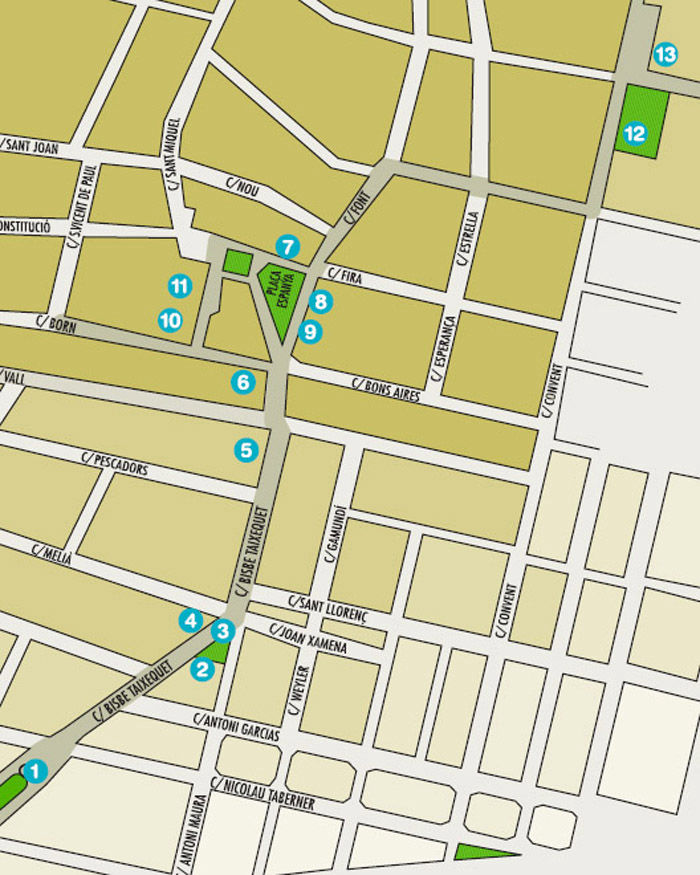
1.- Monument to King James III
The audioguide begins with this monument to King James III. The Kingdom of Majorca was born from the division of the Kingdom of Aragon among the heirs of King James I, the Conqueror, who, after the defeat of the Muslims at the battle of Las Navas de Tolosa in 1212, strategically completed the area of the Aragonese Crown’s reconquest, with the annexation of Valencia and the islands of the Balearic Archipelago. The constant disputes among the descendants of the monarch would culminate in the Battle of Llucmajor, on 25th October 1349, with the death of Majorca’s last King, James III. The result of this defeat was the final annexation of the Kingdom of Majorca to the Crown of Aragon, as a part of the historical process of the formation of the modern states (14th and 15th centuries).
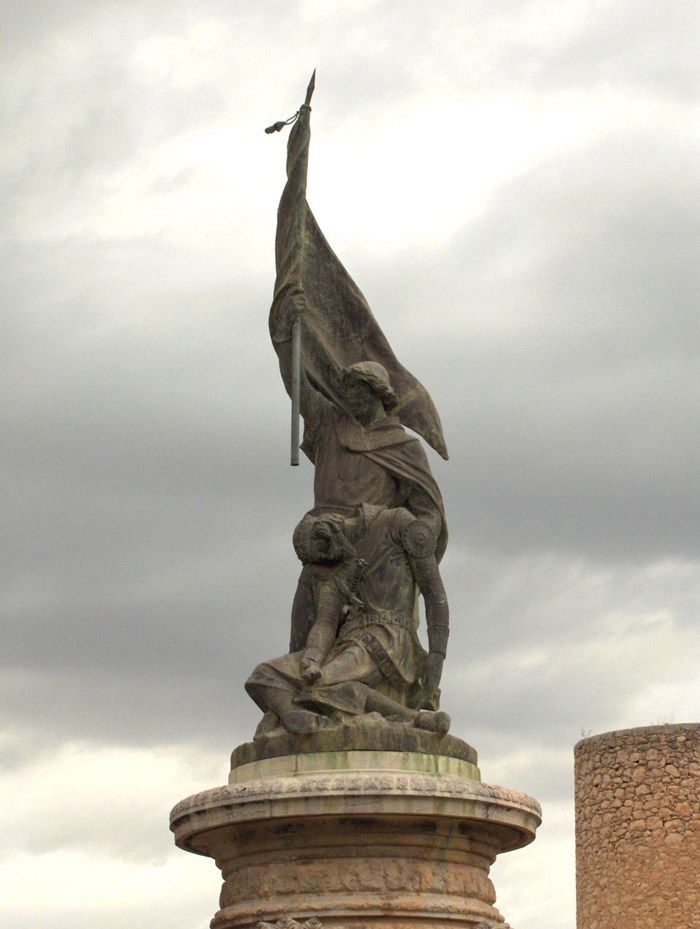
The monument to King Jame III (1) is made in bronze and portrays Prince James, the son of King James III, holding the deceased body of his father and a flag of the former Kingdom of Majorca. Entrusted to architect Rubió Bellver and sculptor Camps Arnau (a disciple of Gaudí), the piece was inaugurated in 1927.
2.- Monument to the cobblers
In the street Bisbe Taixequet we will find a square and there you will see with the audioguide the monument dedicated to the cobblers (2), which was the most common profession among the city’s inhabitants until the 1970s. Made of Santanyí stone, a type of stone typically found on the island, this monument portrays different scenes of the trade. Created by sculptor Tomàs Vila, this monument was inaugurated on 10th August 1963.
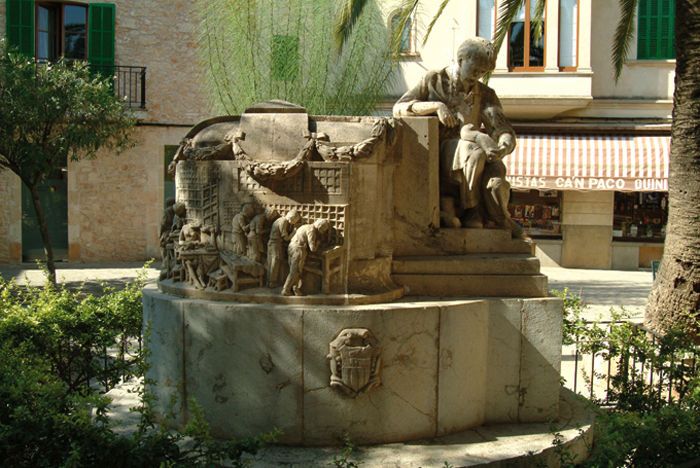
3.- Round Water Trough (S'Abeurador Rodona)
Crowning the square is s'Abeurador Rodona, or the “Round Water Trough” (3), which, as its name indicates, is round in shape. The fountain you can see with the audioguide is made of calcareous stone, has a diameter of three meters, and boasts a central stone column as its only decorative element. Originally used as a water trough for mules and horses, in 1916 the Town Council made a number of changes to it, installing several faucets and thus converting it into a public fountain. In 1963, the square was restored and the water trough was removed, until 1999, when it was finally returned to its original place.
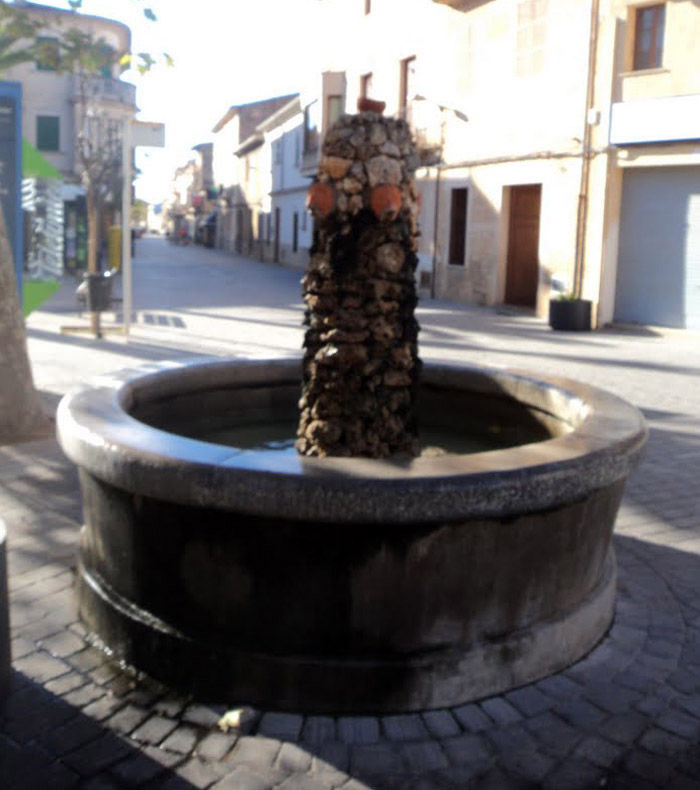
4.- Hotel Espanya
If you look to your left from this very spot while listening to the audioguide, you will see the old Hotel Espanya (4), which was built in 1914. Here lies the silent testimony to the economic wealth that the footwear industry once represented for this city. This hotel frequently accommodated the representatives of leather goods and new shoe models. The building is eclectic in style, bearing the influence of the Art Nouveau in its decorative motifs.
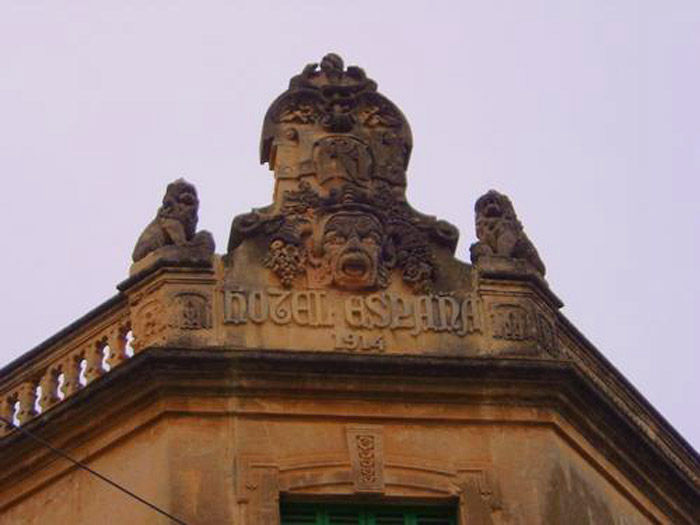
5.- Ca ses Xilenes
Located at number 10 of the street Bisbe Taixequet, is Ca ses Xilenes, or “Home of the Chileans” (5). Currently occupied by the National Institute of Social Security, this neoclassical building was erected in 1925 and named after the daughters of the owner, who were born in Chile, the parents having emigrated in around 1908. This house was built upon their return.
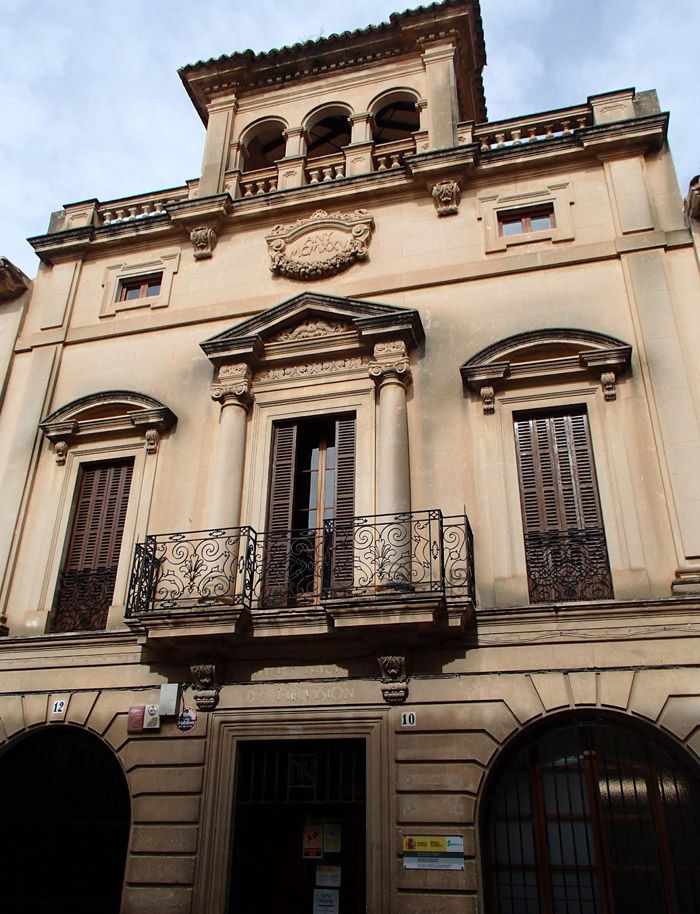
6.- La Caixa building
A bit further down at number 46 is the La Caixa building (6). Built in 1908, this was initially the headquarters of the public agricultural promotion agency, Foment Agrícola. Today it is owned by the savings bank institution, La Caixa. This Neo-Gothic style building was created by Miquel Salvà, who was popularly known as “es capellà Cànaves”, or “Chaplain Cànaves”. In the centre of the building you will be able to see with the audioguide a sculpture of Llucmajor’s coat of arms.
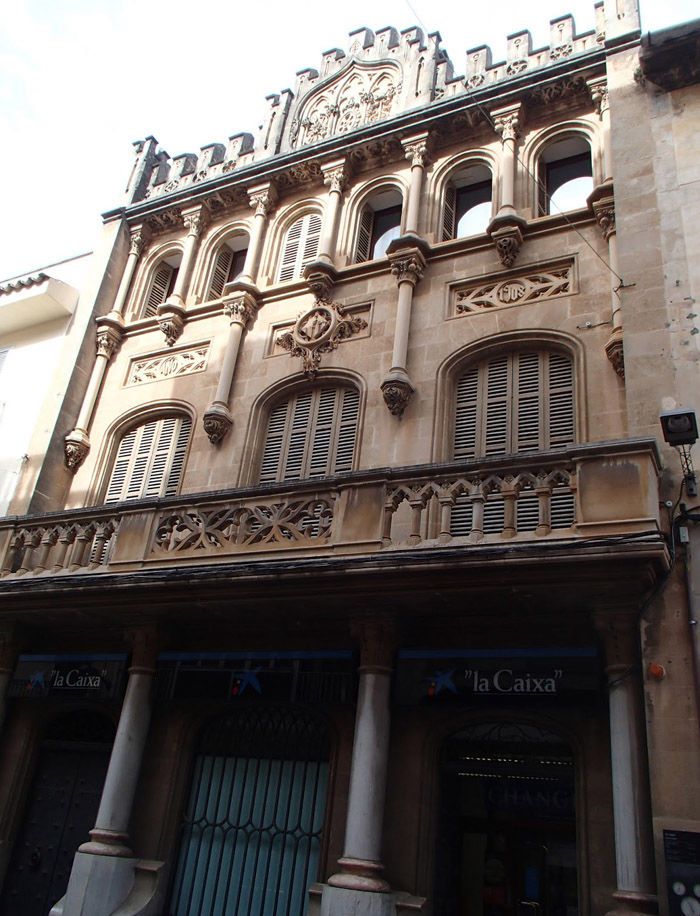
7.- Town Hall Llucmajor
Next section of this audioguide, you will come to the square, Plaça d'Espanya, which is the very heart of the city. At the far end of the square is the Town Hall, or Ajuntament de Llucmajor (7). This eclectic-historicist building was created by Miquel Dalmau, in 1882. The lower section of the façade is clad in Majorcan marble. The upper part of the building boasts a clock and an octagonal zinc shrine, housing a bell, and crowned with a weather vane.
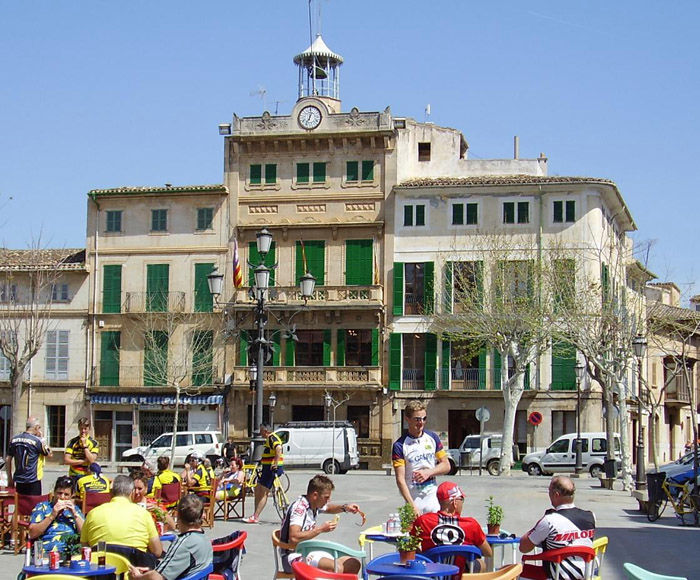
8 y 9.- Café Colón and Bar Tabú
Also worthy of note in this audioguide at this square are the façades of the Cafè Colón building (8) and the Bar Tabú (9), the former Town Hall. The first of these buildings has Art Nouveau airs in its decoration and curved lines (as can be seen in the pediment, windows and other features). The second is eclectic in style, combining classical features with regionalist elements (bevelling in the masonry of the ground floor and the plant motif ornamentation on the windows, etc.).
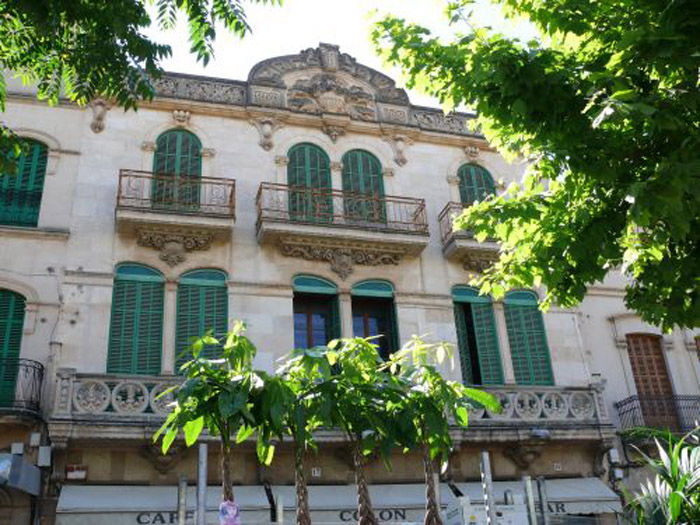
10.- Parish church Sant Miquel
In front of the Town Hall is the impressive Parish of Sant Miquel (10). Indeed, this is the city’s most emblematic building, as it can be seen at a certain distance from any of Llucmajor’s access roads. It is also the largest church in Majorca, second only to Palma’s main Cathedral.
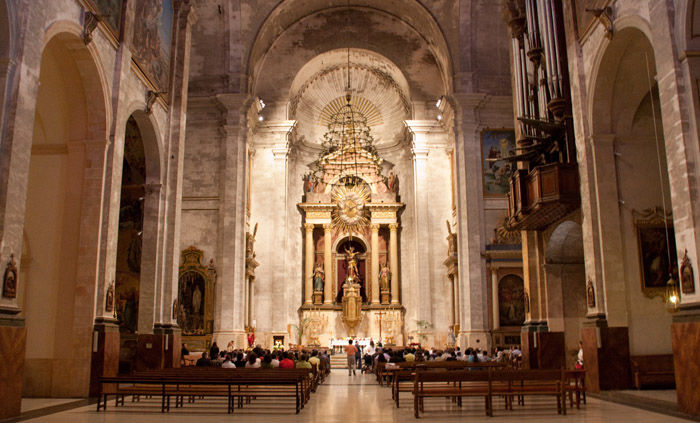
11.- House of the parish priest
Attached to the church is the Casa Rectoral, or home of the parish priest (11). This building you can visit with the audioguide offers an example of the stately homes built on the island during the 18th century, bearing a coat of arms on the balcony and a sundial on the façade. Sundials are in fact typical of Llucmajor, this being one of the European municipalities with the largest numbers of sundials.
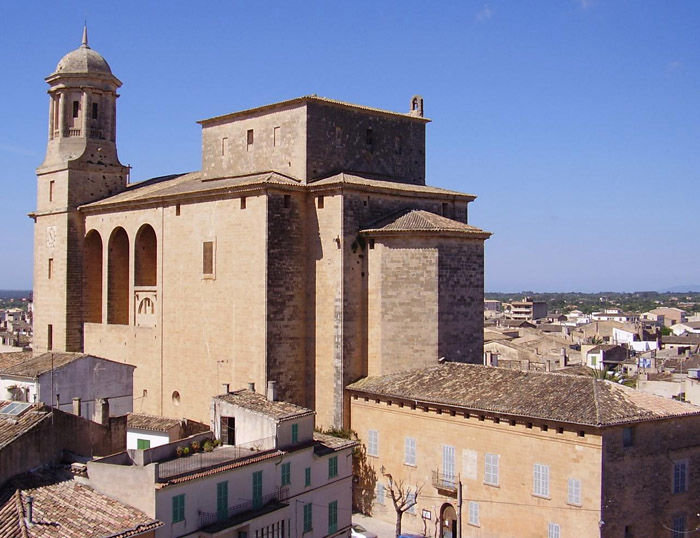
12.- S'Espigolera
Occupying the centre of the square is the statue S’Espigolera (12), a monument dedicated to the town’s native poet Maria Antònia Salvà. This bronze statue was created in 1965 by sculptor Horacio de Eguía, who was inspired by one of the poet’s poems, titled “L’Espigolera”. The monument you can see with the audioguide portrays a little girl in braids carrying a bundle of ears of grain. This local traditional scene was something that Maria Antònia Salvà witnessed frequently, as the girls used to follow the grain threshers, picking up the sparse ears of grains that they would leave behind.
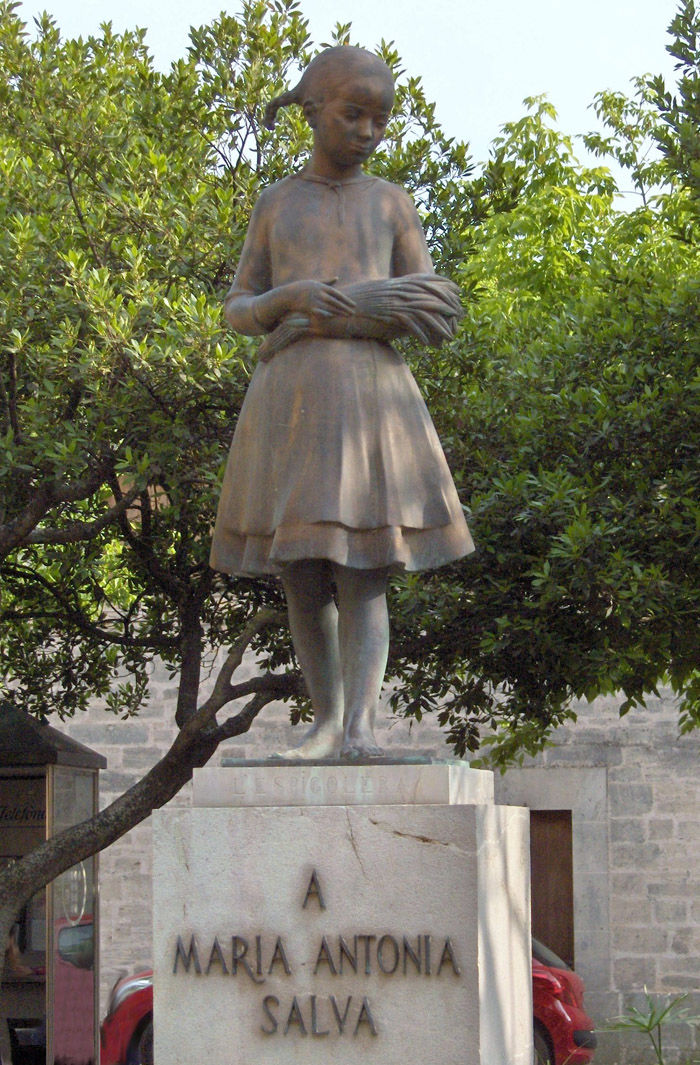
13.- Convent Sant Bonaventura
On the opposite side of the square is the Convent and Church of Sant Bonaventura (12). The first request for authorisation to establish a convent in Llucmajor dates from the year 1576. The initiative came from the Convent de Jesús in Palma, which was founded by Father Catany, a native of Llucmajor. Priests and other preachers from that centre came to the estates of the town in pursuit of alms. Whilst the Carmelites attempted to establish themselves in Llucmajor, the town decided that it would be the Franciscans who would settle there. Following the bureaucratic formalities, the first Franciscans occupied the first monastery, located in the street of the same name (Monestir). Initially, the Franciscans subsisted on funding from the Town Council.
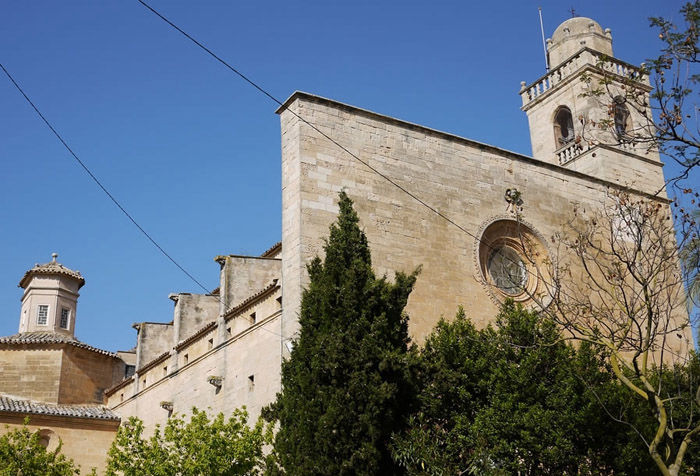
The Franciscans soon became close to the people, carrying out their apostolic work, and going so far as to offer educational centres for cultural exchange, in addition to serving the ill and the poor. The convent of Llucmajor was quick to become an important centre of Christian faith and culture.
In 1608 the Franciscans moved the current location, and the church was built between 1620 and 1656. The convent was erected after the temple, during the second half of the 17th century. The temple follows the Renaissance style, with sombre and elegant lines.
The main portal is Baroque and dates back to the 18th century, with the porta coeli, or “door to heaven”, typical of Franciscan temples. The side niches, which are empty today, once bore statues of Saint Francis and Ramon Llull. In the centre of the upper section sits the Blessed Virgin, and the portal is crowned with the Franciscan coat of arms. Presiding over it is the cross. Above the main door is a rose window with concentric mouldings, with a sundial to the right. Overlooking the side door with the audioguide, which is also Baroque, is Saint Bonaventure. The base of the belfry is square, its upper section enclosed within a balustrade.
Particularly worthy of note inside is the Capella de Betlem, or “Chapel of Bethlehem”, an object of great worship among the Franciscans. The main altarpiece is Baroque in style and dates from the late 17th century. Sustaining the choir are segmental arches. The organ was also built at the end of the 17th century. The vestry is located to the right of the presbytery and was built between 1694 and 1697.
Among Llucmajor’s distinguished native Franciscans, mention must be made of Father Boscana (1775-1831), who played an important role in California’s Mission of San Juan de Capistrano.
14.- Cloister Sant Bonaventura
On June 3rd, 1608 the Franciscans placed in this location after living in a house in the street Monestir since1599. The definitive conventual enclosure was constructed during the 17th century and it was formed by the church, the cloister, small attached buildings and the garden. The temple was blessed by Pere Roig i Noguera in 1656, on October 29th.
The internal areas of the convent you can visit with the audioguide: cells, offices, workshops, refectory, kitchen, desk, library, toilets, meetings room, were distributed around the cloister; the construction of the low floors finished about 1670 and the first floor about 1697. It follows the typical monastic Franciscan baroque construction: the ground floor is squared with double gallery superposed of round arches. The lower gallery is covered with a mirror vault whereas the vault of the upper floor is of beams.
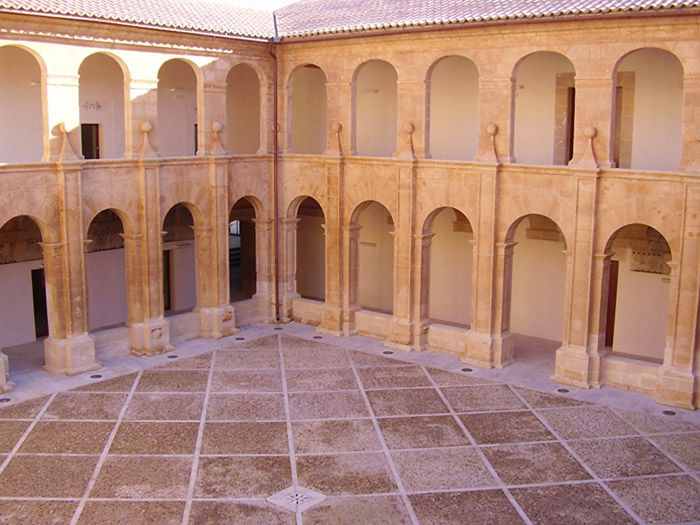
The conventual enclosure was occupied by the Franciscan order up to Mendizábal's Confiscation that took place on March 10th, 1836. From this moment and until 1998, year in which the Guardia Civil left definitively the cloister and its dependences, the cloister was a barrack of the Guardia Civil, Town court and Municipal Slaughterhouse.
For that, in 1999 began the project of restoration and recovery of the building, declared Building of Cultural Interest on August 23rd, 2002. The works of restoration began on April 28th, 2006, day in which there was celebrated the symbolic act of the placement of the first stone. The inauguration of the cloister took place on June 27th, 2007. Today it has turned into a cultural centre where it is possible to see a collection of painted original tiles and grisaille paintings of the 18th, besides other exhibitions.
15.- Prehistoric settlement of Capocorb Vell
Next section of this audioguide, the prehistoric settlement of Capocorb Vell in southern Llucmajor is the most famous example of a Bronze Age settlement. Capocorb Vell is situated on eminently flat land 100 m above sea level and consists of a nucleus of three round and two square talaiots, surrounded by different outlying buildings and a series of talaiots and other types of buildings on the periphery.Capocorb Vell is unique in the western Mediterranean. MA6014, Km. 23. Opening times: 10.00 a.m. to 4.30 p.m. Closed on Thursday.
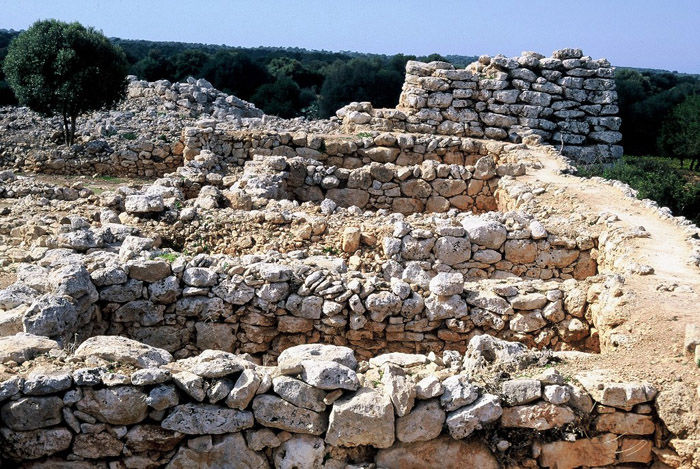
16.- Church La Lactancia in s'Arenal
The works of the old parish church "Nuestra Señora de la Lactancia in S'Arenal" in neogothic style began in 1896 and the first part of the chapel was blessed and the works finished in 1902. Due to the population increase of S'Arenal, the temple became small and the works of the new temple began in August 1969, conserving the old temple. This temple was inaugurated in May 1971 and in October 1981 the high altar was consecrated.
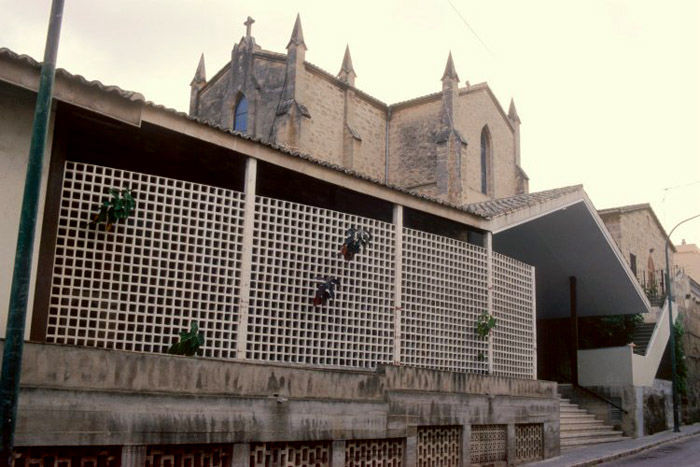
17.- Sanctuary Nostra Senyora de Gràcia
The Sanctuary of Nostra Senyora de Gràcia was erected at the end of the XVth century after constructing the church. The first church was gothic and at the present time there is not concrete information about it. The present church you can see with the audioguide was concluded in 1819 and to its left there is the guesthouse (XVIIIth century) which occupies what they were long ago the cells of the hermits.
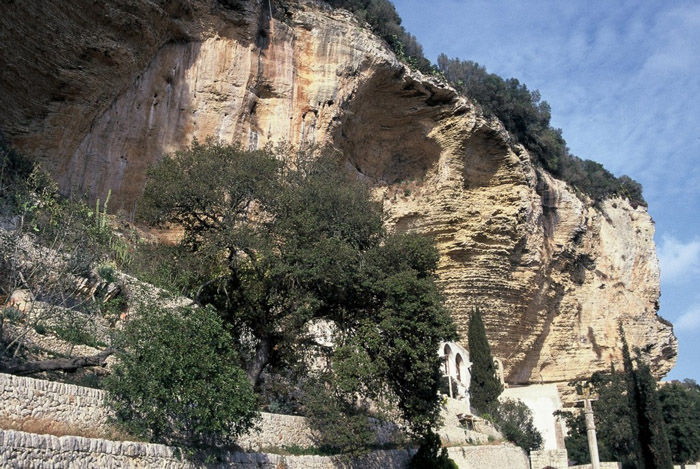
Celebrations
Both in Llucmajor and in S’Arenal will be celebrated on January 5th the Three Wise Men cavalcade. In the same month, take place the celebrations of “Sant Antoni”, with typical bonfires "foguerons" at any square and people eat and drink in the street. After the liturgical celebration in honour to Sant Antoni, animals and pets will be blessed.
During the carnival celebrations there are parades in Llucmajor and S'Arenal.
The Sunday after Easter Sunday (Diumenge de l'Àngel) people go in peregrination to the "Sanctuary of Gràcia" (Llucmajor) or to the "Pont de ses Set Boques" in S'Arenal.
In S'Arenal will be celebrated the festivity of the patron saint, Sant Cristòfol, on July 10th with concerts and activities at the Plaça Major, and the celebrations of “El Rocío” in April.
The second Sunday of August we celebrate the festivity of "Santa Càndida”, patron saint of Llucmajor with open air concerts at the Plaça Espanya.
Fairs and markets
The Llucmajor Fairs are among Mallorca´s oldest and most important events and are worth mentionning in this audioguide. The first takes place on September 29 (the feast day of San Miguel, the city's patron saint) and a series of other fairs which specialise in traditional products and feature an extensive programme of entertaining and cultural activities are held on the following three Sundays. The event known as la Darrera Fira (the Last Fair) falls on the last Sunday and attracts a large number of stands and crowds of visitors. The fair season comes to a close with the Firó festivities on the Monday after the Last Fair.
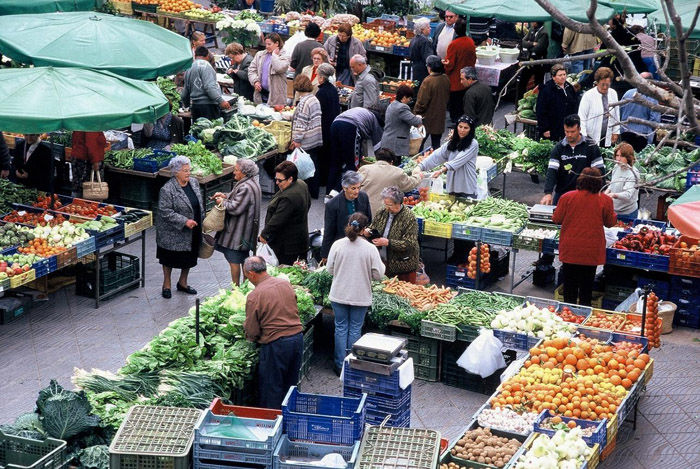
Fairs
Saint Michael Day. Primera Fira September 29th
Darrera Fira Sunday before October 18th
Es Firó Monday before October 18th
Weekly Markets
Llucmajor Fruits & vegetables market: Wednesdays, Fridays & Sundays Flea market: Fridays
S'Arenal Fruits & vegetables market: Tuesdays, Wednesdays, Fridays & Saturdays Flea market: Thursdays
Les Palmeres Fruits & vegetables market: Saturdays
Badia Gran Fruits, vegetables & flea market: Saturdays
Cala Pi Fruits & vegetables market: Wednesdays in the afternoon from June to September
S'Estanyol Fruits & vegetables market: Saturdays in the afternoon from June to September
Sa Torre Fruits & vegetables market: Thursdays
Handicrafts
Llucmajor offers to all the visitors its traditional and rich handicrafts. The old manufacture trades are still alive in the local daily activity, preserving a very important part of our socio-cultural legacy.
The preservation and maintenance of the production techniques, transmitted from parents to sons, together with the craftsmen skill and creativity, contribute to the production of unique pieces of unquestionable beauty and value, very appreciated by a very demanding consumer who looks for exclusive design products. Know and enjoy the charm, the creativity and the diligence of our handicrafts
Bluehertz Audio guides has developed for Llucmajor´s town hall an audio guide service avaliable in Spanish, English, German and French languages.
Llucmajor´s Tourist Office address: Pl. Espanya. Antic mercat municipal. 07620 Llucmajor, Mallorca, Islas Baleares.
- Tel.: 971 669 162 - www.visitllucmajor.com - turismo@llucmajor.org -
Back to index